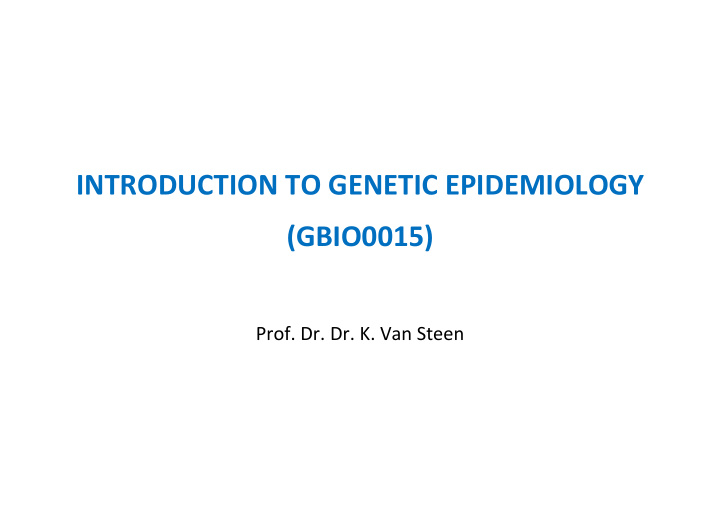



INTRODUCTION TO GENETIC EPIDEMIOLOGY (GBIO0015) Prof. Dr. Dr. K. Van Steen
Introduction to Genetic Epidemiology Family-based Association Studies FAMILY-BASED GENETIC ASSOCIATION STUDIES 1 Setting the scene 1.a Introduction 1.b Association analysis Linkage vs association 1.c GWAs Scale issues K Van Steen
Introduction to Genetic Epidemiology Family-based Association Studies 2 Families versus cases/controls 2.a Every design has statistical implicationse How does design change the selection of analysis tool? 2.b Power considerations Reasons for (not) selecting families? 2.c The transmission disequilibrium test Pros and cons of TDT 2.d The FBAT test Pros and cons of FBAT K Van Steen
Introduction to Genetic Epidemiology Family-based Association Studies 3 From complex phenomena to models 3.a Introduction 3.b When the number of tests grows Multiple testing 3.c When the number of tests grows Prescreening and variable selection K Van Steen
Introduction to Genetic Epidemiology Family-based Association Studies 4 Family-based screening strategies 4.a PBAT screening Screen first and then test using all of the data 4.b GRAMMAR screening Removing familial trend first and then test K Van Steen
Introduction to Genetic Epidemiology Family-based Association Studies 5 Validation 5.a Replication What is the relevance if results cannot be reproduced? 5.b Proof of concept 5.c Unexplained heritability What are we missing? Concepts: heterogeneity K Van Steen
Introduction to Genetic Epidemiology Family-based Association Studies 6 Beyond main effects 6.a Dealing with multiplicity Multiple testing explosion … 6.b A bird’s eye view on a road less travelled by Analyzing multiple loci jointly FBAT-LC 6.c Pure epistasis models MDR and FAM-MDR 7 Future challenges K Van Steen
Introduction to Genetic Epidemiology Family-based Association Studies 1 Setting the scene 1.a Introduction to genetic associations A genetic association refers to statistical relationships in a population between an individual's phenotype and their genotype at a genetic locus. Phenotypes: - Dichotomous - Measured - Time-to-onset Genotypes: - Known mutation in a gene (CKR5 deletion, APOE4) - Marker or SNP with/without known effects on coding K Van Steen
Introduction to Genetic Epidemiology Family-based Association Studies 1.b Basic mapping strategies Using families: linkage versus association Linkage is a physical concept: The two loci are “close’ together on the same chromosome. There is hardly any recombination between disease locus and marker locus Association is a population concept: The allelic values at the two loci are associated. A particular marker allele tends to be present with disease allele. Marker locus Disease locus (A1,A2 alleles) (D,d alleles) K Van Steen
Introduction to Genetic Epidemiology Family-based Association Studies Features of linkage studies Linkage exists over a very broad region, entire chromosome can be done using data on only 400- 800 DNA markers Broad linkage regions imply studies must be followed up with more DNA markers in the region Must have family data with more than one affected subject (Figure: courtesy of Ed Silverman) K Van Steen
Introduction to Genetic Epidemiology Family-based Association Studies Features of association studies Association exists over a narrow region; markers must be close to disease gene - The basic concept is linkage disequilibrium (LD) Used for candidate genes or in linked regions Can use population-based (unrelated cases) or family- based design K Van Steen
Introduction to Genetic Epidemiology Family-based Association Studies 1.c Genome wide association analyses (GWAs) Reasons for continuing popularity of GWAs The impact on medical care from genome-wide association studies could potentially be substantial. Such research is laying the groundwork for the era of personalized medicine, in which the current one size-fits-all approach to medical care will give way to more customized strategies. … It will take more than SNPs alone K Van Steen
Introduction to Genetic Epidemiology Family-based Association Studies (Kraft and Hunter 2009) … It will take more than SNPs alone K Van Steen
Introduction to Genetic Epidemiology Family-based Association Studies (Sauer et al 2007) K Van Steen
Introduction to Genetic Epidemiology Family-based Association Studies Reasons for continuing popularity of GWAs using SNPs There is a large compendium of validated SNP data SNP GWAs are able to potentially use all of the data They are more powerful for genes of small to moderate effect (see before) They allow for covariate assessment, detection of interactions, estimation of effect size, … BUT ALL statistical issues cannot be ruled out K Van Steen
Introduction to Genetic Epidemiology Family-based Association Studies (Hunter and Kraft 2007) K Van Steen 708
Introduction to Genetic Epidemiology Family-based Association Studies Using all of the data for case/control designs? candidate gene approach Frequency vs Effect Size genome-wide screening approach K Van Steen
Introduction to Genetic Epidemiology Family-based Association Studies Using all of the data for case/control designs ? There are many (single locus) tests to perform The multiplicity can be dealt with in several ways - clever multiple corrective procedures (see later) - adopting multi-locus tests (see later) or - haplotype tests, - pre-screening strategies (see later), or - multi-stage designs. Which of these approaches are more powerful is still under heavy debate… K Van Steen
Introduction to Genetic Epidemiology Family-based Association Studies 2 Families versus unrelated cases and controls 2.a Every design has statistical implications There are many possible designs for a genetic association study (Cordell and Clayton, 2005) K Van Steen
Introduction to Genetic Epidemiology Family-based Association Studies Family-based designs Cases and their parents Test for both linkage and association Robust to population substructure: admixture, stratification, failure of HWE Offer a unique approach to handle multiple comparisons Using trios Disequilibrium Test (TDT) Transmission K Van Steen 712
Introduction to Genetic Epidemiology Family-based Association Studies 2.b Power considerations Rare versus common diseases (Lange and Laird 2006) K Van Steen 713
Introduction to Genetic Epidemiology Family-based Association Studies Power Little power lost by analysing families relative to singletons It may be efficient to genotype only some individuals in larger pedigrees Pedigrees allow error checking, within family tests, parent-of- origin analyses, joint linkage and association, ... (Visscher et al 2008) K Van Steen 714
Recommend
More recommend